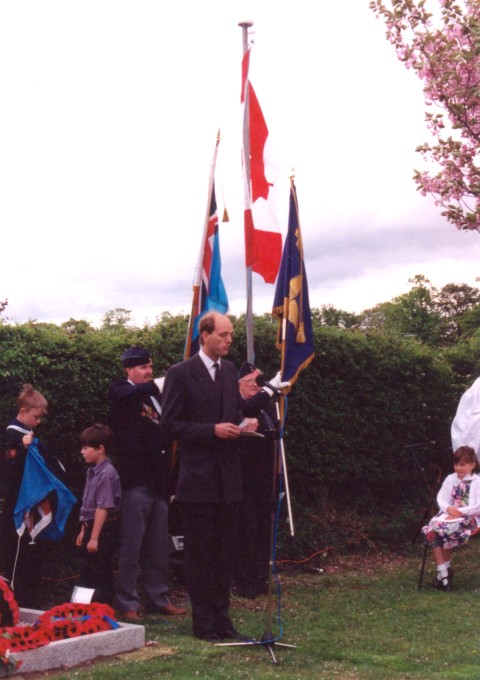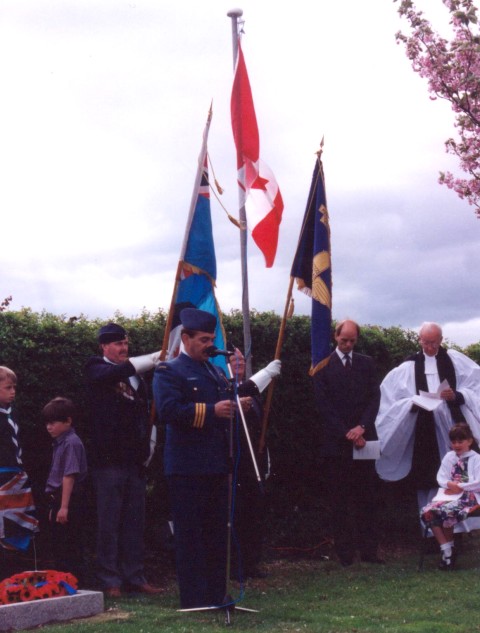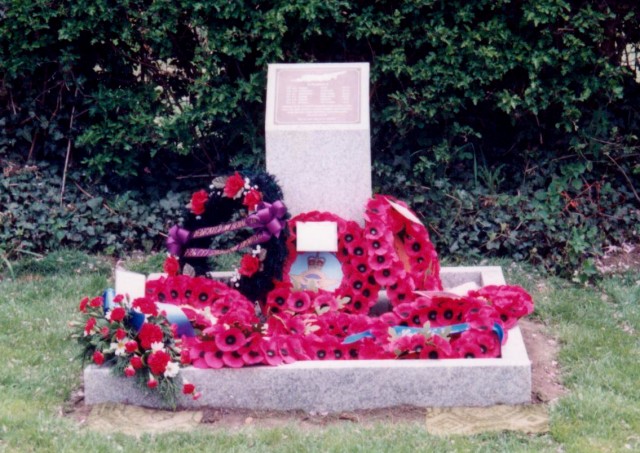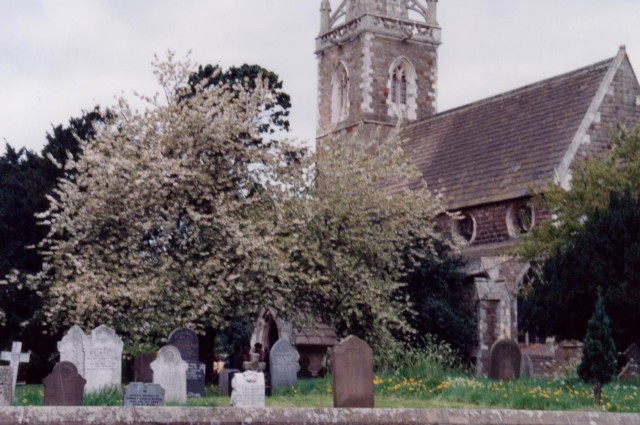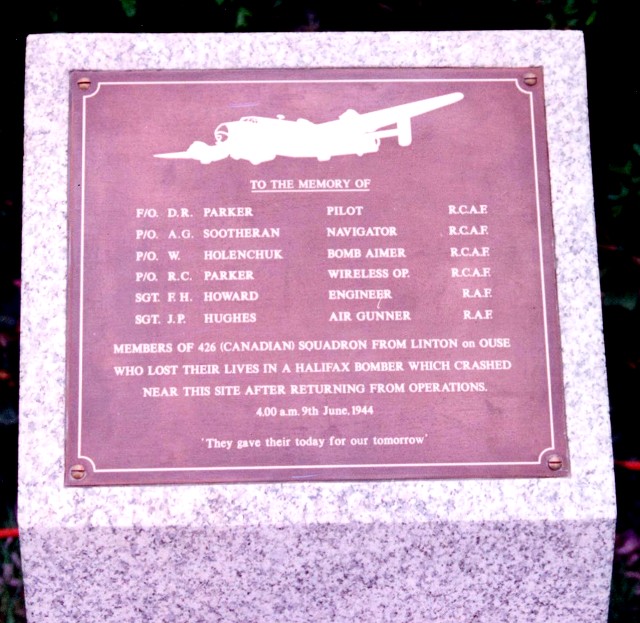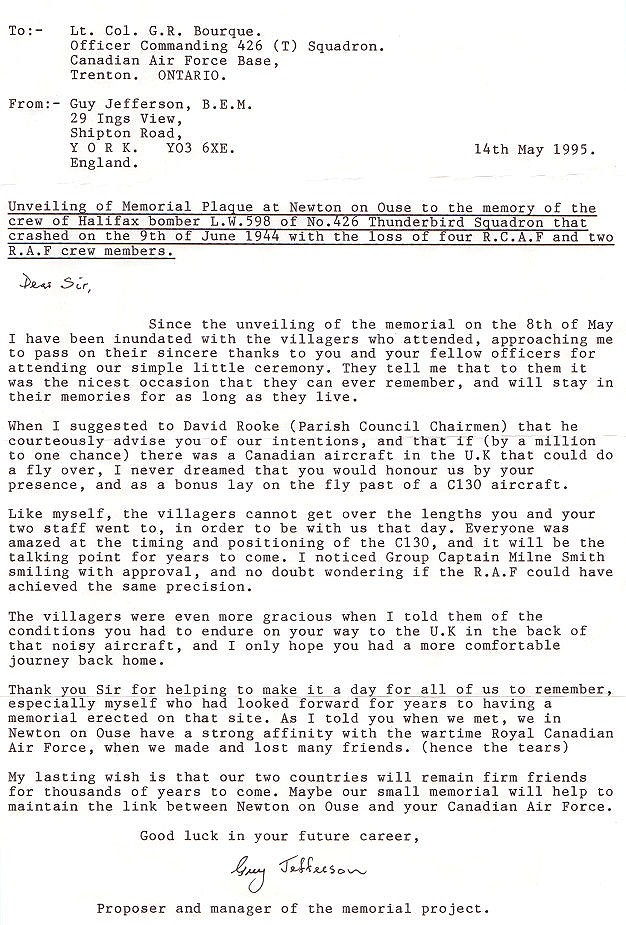Newton-on-Ouse Cairn
| On 8 May 1995, a delegation of 426 Squadron Association members, and current serving members, attended and participated in a ceremony at All Saint's Church, Newton-on-Ouse. The occasion was the dedication of a cairn and commemorative plaque in the memory of the members of Halifax III, LW598/OW "J", who died in a crash near that site. D.W. Rooke, Chairman, Parish Council, Newton-on-Ouse addresses the gathering. |
| LCol J.D.R. Bourque, CO, speaks on behalf of the squadron. |
The Memorial is adorned with wreathes and flowers. | |
All Saint's Church and yard, instituted 6 Oct 1229, where many simple crosses commemorate airmen who lost their lives on active service, and close to the crash site. | |
On the night of 8/9 Jun 44, ten No 426 Sqn Halifaxs were assigned to attack the railway centre at Mayenne, France, as part of an 80 aircraft raid by No 6 Group. At the target they found heavy cloud between 5000 and 7000 feet, but fair visibility below, and dropped their loads with good results at about 0145 hours. Back at Linton, the weather had closed in, and Flying Control issued diversion instructions to airfields in England, Scotland and even Northern Ireland. P/O N.L. Craig and crew, Halifax III, LW598/OW "J", was over Linton when the diversion broadcast was received. On consulting his navigator, WO2 A.G. Sootheran, and the fight engineer, Sgt F.H.G. Howard, Craig determined they barely had enough fuel to make the alternate airfield. The pilot decided to check visibility and brought the Hali down to 800 feet where he saw breaks in the clouds, and glimpsed the airfield lighting system. He then positioned his aircraft for landing and lowered the undercarriage. At that very moment, the head of a cylinder on the starboard inner engine blew off, fire poured from the gills of the engine. Craig had to focus his attention on extinguishing the fire and feathering the prop. By this time, the Hali was in a low, slow glide and, as Craig struggled to put out the fire, it collided with a house in the village of Newton-on-Ouse. The starboard wing struck first, then the two starboard props hit a brick wall and flew off; finally, the aircraft crashed into a field opposite, spinning around and sliding sideways into another house, which it demolished. As soon as the Hali came to rest, the enginefire began to spread. Of the entire crew, only the mid-upper gunner, F/S E.S. Neill, managed to get himself clear of the burning wreck. He was badly shaken up and slightly injured but, with the help of Cpl R.J. Swift of the Service Police (who was the first to arrive on the scene), he went back and dragged out four other members of the crew. They found only Craig alive, and he was unconcious and badly hurt. A firefighting team was sent from the airfield, a mile and a half distance to bring the blaze under control. Neill and the firemen rescued an elderly woman from under about two feet of masonry rubble and large chunks of aircraft wreckage, where she had been buried for about an hour. Neill also helped rescue the Camamile family, which included two small children, the residents of the first house struck in the crash. For his cool courage in great danger, Neill, Windsor ON, received the British Empire Medal. Craig, Victoria BC, eventually recovered from his severe injuries. The Canadians, second pilot, Parker, Ottawa ON, the navigator, Sootheran, Niagara Falls ON, the bomb aimer, Holenchuk, Portage La Prairie MB, and the wireless operator, Parker, Edmonton AB, were buried in Stonefall Cemetary, Harrogate, Yorkshire. Howard was buried in Streatham Park Cemetary, Mitcham, London, and Hughes was buried in St. Kentigern's Cemetary, Glasgow. | |
| |
| |















































